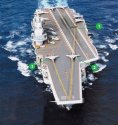Thats what they have calculated against, thats the max Mtow any jet is allowed from the aft launch point. Also i think the shorter takeoff mark(115) collinear to longer takeoff mark (187) will be used only when jets are landing simultaneous to launchings and therefore, while quickly launching all jets related to a mission, the ratio of aircraft taking of from aft and fore points will be 1:1.Why are you assuming (140 + 47) m and not (68 + 47) m as the launch point distance? What is the end speed based on MTOW of 29 tons?
The calculations for jets launching from fore point are more arduous since the aircraft will be depending heavily on its high AoA performance until it reaches V2min speed, and slight differential in assumption may end up giving huge variation in results.
Therefore, it makes sense to calculate a safe velocity from end of ski deck, that is derived directly from stall speed characterisitcs of basic flight of the same jet.
At 29 tons tow, with 26 ton thrust, considering 0 headwind and 10% allowance for Fr, Drag etc, the takeoff velocity will be 200 kmph and AoA of 15°. That would mean lift creating horizontal velocity of 190kmph and a throwup velocity of 50kmph.
The 50kmph is what has to be traded to buy time for creating extra lift.



